Abstract
We introduce the Ising Network Opinion Formation (INOF) model and apply it to the analysis of networks of six Wikipedia language editions. In the model, Ising spins are placed at network nodes/articles and the steady-state opinion polarization of spins is determined from the Monte Carlo iterations in which a given spin orientation is determined by in-going links from other spins. The main consideration was the opinion confrontation between capitalism, imperialism (blue opinion) and socialism, communism (red opinion). These nodes have fixed spin/opinion orientation while other nodes achieve their steady-state opinions in the process of Monte Carlo iterations. We found that the global network opinion favors socialism, communism for all six editions. The model also determined the opinion preferences for world countries and political leaders, showing good agreement with heuristic expectations. We also present results for opinion competition between Christianity and Islam, and USA Democratic and Republican parties. We argue that the INOF approach can find numerous applications for directed complex networks.
1. Introduction
The emergence of social networks, characterized by scale-free properties (see, e.g., [1,2]), produced an important impact on human society. Thus, opinion formation in such social media is argued to influence even political elections (see, e.g., [3,4]). This implies that the understanding of opinion formation on social networks represents an important challenge. Various voter models on networks had been developed for the analysis of opinion formation as described in [1,5,6,7,8,9,10,11]. Recently, the opinion formation on the world trade network has been argued to be linked with country preference to trade in one or another currency (e.g., USD or hypothetical BRICS currency) [12]. An important new element that appeared in these studies is that the opinion of certain countries (network nodes) is considered to be fixed since it is assumed that they prefer to always trade with a fixed currency of USD or BRICS. This raises the question of how important the influence of specific selected nodes with opposite opinions is on a global opinion configuration in complex directed networks.
A network with N nodes and two opinions can be viewed as a generalized Ising model with spins . The total number of opinion (or spin) configurations in such a system is huge, being . It is natural to assume that a given voter’s, or node’s, opinion is determined by the opinions of directly linked neighbors, which makes the problem similar to a spin polarization (or magnetization) in the Ising model: if the neighboring spins of a specific spin, or a voter, are mainly up-oriented (red color), then this spin also turns up; or, if the neighboring spins are down-oriented (blue color), then the spin turns down. Such an approach to opinion formation on various networks has been applied in many cases and analyzed in the above-cited publications.
In this work, we study the problem of opinion formation induced by a group of nodes with fixed polarization (opinion) in the Wikipedia networks of different languages (up to six languages, with English–EN, German–DE, Spanish–ES, French–FR, Italian–IT, Russian–RU). We use network data sets from Wikipedia, collected in 2017, and publicly available at [13]. The important advantage of Wikipedia networks is that the meaning of their nodes is clearly defined by the corresponding Wikipedia articles. A number of features of WIKI2017 networks has been studied, e.g., in [14,15]. A great variety of applications of Wikipedia in academic and societal research was reviewed in [16,17,18,19].
In these WIKI networks, we consider the confrontation and influence of groups of opposite fixed opinions (spins) given by the following nodes (articles): capitalism (blue color, ) and socialism (red color, ) and the extended case when each group is formed by two-by-two nodes: capitalism, imperialism and socialism, communism (each language edition determines these articles by a corresponding transcription). We also briefly consider interactions and the influence of two other opposite groups with fixed opinions/spins given by the articles Christianity and Islam, and also Democratic Party (United States) vs. Republican Party (United States). The description of data sets, Monte Carlo procedure of spin interactions, and obtained results are presented in the next sections.
After the seminal work of Karl Marx in 1867 [20], a great variety of research investigations appeared about the conflict between capitalism and socialism, based on economic and sociological science analysis (see, e.g., [21,22] and Refs. therein). Here, we used another purely mathematical and numerical analysis of the Wikipedia networks of six language editions, which allowed us to determine the opinion preference for socialism or capitalism globally for an entire edition and also for specific Wikipedia articles, such as world countries and historical political figures. A clear meaning for each Wikipedia article also allowed us to test the efficient and weak features of our INOF approach. Since Wikipedia accumulates a huge amount of human knowledge [16,17,18,19], we think that the obtained results are of general public interest.
The article is composed as follows: Section 2 describes the Ising Network Opinion Formation (INOF) model, data sets, and numerical methods, Section 3 presents results of the confrontation of opinions for capitalism and socialism, Section 3 considers interactions between Christianity and Islam, and competition between the US Democratic and Republican parties is studied in Section 4, statistical features of the proposed INOF model are discussed in Section 5, and a discussion and conclusion are given in Section 6.
2. Model Description and Data Sets
We call the approach described below of opinion formation on directed networks the Ising Network Opinion Formation (INOF) model. Here, in the first Subsection, we give a detailed description of the INOF model and related data sets and, after that, in the second Subsection, we describe qualitative features of the model and give certain clarifications.
2.1. Description in Detail
We used Wikipedia networks from 2017 with their six language editions; data sets were taken from [13]. Thus, the EN-wiki network has about nodes, while the other five networks have about and million nodes; the exact number of nodes and links are given in [14]. For the EB edition, there are about million links; the other five editions have approximately the same ratio between the number of links and nodes .
We characterized all network nodes by their PageRank vector probability [23,24,25] normalized to unity (); thus, all nodes obtain the PageRank index K that orders nodes by a monotonically decreasing probability with the highest probability at and smallest at . The PageRank vector is the eigenvector of the Google matrix G [23,24,25] with the highest eigenvalue : and . The statistical properties of link distributions have been discussed in [25] and we do not return to them in this work. Here, is the matrix of Markov transitions between nodes constructed from the adjacency matrix ; thus, where is a number of out-going links from node j to node i; for dangling nodes without out-going links, and . We used a standard value of the damping factor [23,24,25]; it regularizes the network connecting all isolated communities. Here, we do not discuss the statistical properties of the link distributions discussed in detail in [25] and Refs. therein.
To determine the steady-state configuration of spins on a given network, we mainly follow an asynchronous Monte Carlo procedure described in [12], with an additional important modification. The selected nodes (wiki-articles) have assigned fixed spin values ( blue for capitalism and red for socialism; this is called option-1 (OP1); or, for capitalism and imperialism and for socialism and communism; this is called option-2 (OP2)). Differently from [12], all other nodes are supposed to have a white color (or spin ) at the initial stage of the Monte Carlo process; we call this a white option. Such a choice for the initial state of all spins corresponds to a situation when all other spins, those which are not fixed, have no definite opinion at initial stage. Then, randomly, we choose a spin i, which is not fixed, and compute its influence score from in-going links j:
where the sum is performed over all nodes j pointing to i; is the matrix of Markov transitions where the columns of dangling nodes have zero elements (dangling nodes give no contribution to ). Furthermore, if the spin of j node is oriented up, if it is oriented down, or if node j has no opinion (belongs to the initial set of the white option). After the computation of value , a spin of node i takes the value if , if , or stays unchanged if . Then, such a random iteration is conducted for another random node , without repetition for the previously visited nodes. We used a random shuffle to perform this operation. Thus, after N random iterations (fixed nodes remain fixed), we complete a full time step with time , and then the entire procedure is repeated, going to . The process of convergence to a steady state is shown in Figure 1. We find that, at , the process converges to a steady-state distribution of spins with a fixed final fraction of red nodes with spins up and a final of blue nodes with spins down. There is a small fraction of nodes that remains white at that we attribute to the presence of isolated communities [25]. However, the number of such nodes is relatively small (e.g., for OP2, we have for EN; DE; FR; RU; IT; ES Wikipedia editions, respectively). We do not take into account these final white nodes from isolated communities, considering only red and blue nodes in the final steady state with a natural normalization of their fractions . We also characterize the final state by its polarization (or magnetization) of spins, given by .
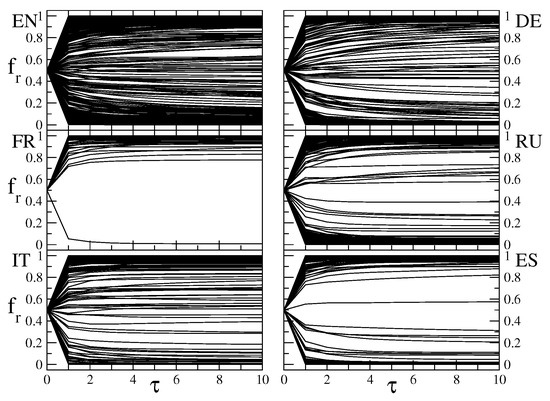
Figure 1.
Evolution of the fraction of red nodes for 500 random pathway realizations. An initial condition has two fixed red nodes (socialism, communism) and two blue nodes (capitalism, imperialism); they remain fixed during the Monte Carlo evolution with the relation (1); all other nodes are initially white. Each panel corresponds to one of the six language editions of Wikipedia: EN (English), DE (German), FR (French), RU (Russian), IT (Italian), and ES (Spanish). The x-axis represents time , where each unit of indicates one complete update of all nodes/spins following the opinion model based on relation (1).
However, we should note that, in the Monte Carlo process, one can choose various random orderings of spin flip defined by the rule (1) and, thus, we obtain various random realizations of the pathway ordering of spins, forming various random pathways leading to a final steady-state distribution. In fact, we find that different random pathways generally lead to different final configurations of spins, as it is shown in Figure 1. Due to that, we perform an averaging over random pathway realizations (we call this 1000 pathways a slot). The histograms of fractions of red nodes obtained from realizations are shown in Figure 2 and Figure 3 for Wikipedia editions and options OP1 and OP2, respectively. By calculating the average of these random realizations, we obtain the steady-state values of and for each node (spin) i. By definition, . Thus, after averaging over all realizations, each node i is characterized by its average values (we will speak mainly about the fraction of red nodes), , and its deviation from global polarization . After averaging over all nodes, we obtain the global network values of red and blue node and global network polarization . We checked that the probability distributions of Figure 2 and Figure 3 remain unchanged if we increase the time from to . Thus, all the results are taken from the steady state at . The results with an increased number of realizations, up to , are discussed in Section 6.
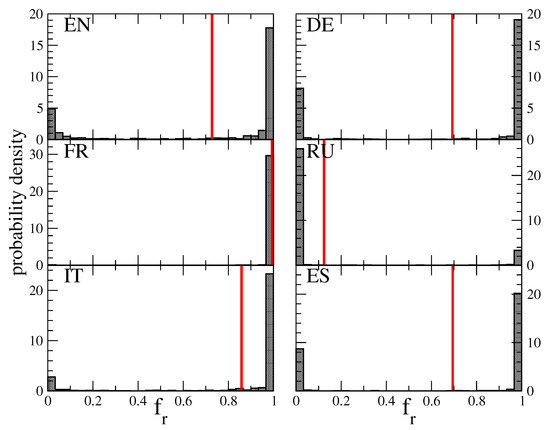
Figure 2.
Probability density p of the fraction of red nodes () for 1000 realizations after . Each panel, for OP1, corresponds to one of the six different languages of Wikipedia for the initial condition with one fixed red node (socialism) and one blue node (capitalism). The vertical red lines mark the mean value of with an average global polarization of . The values of the mean polarization are for EN, for DE, for ES, for FR, for IT, and for RU. The histogram is built with a cell size and normalized to 1 ().
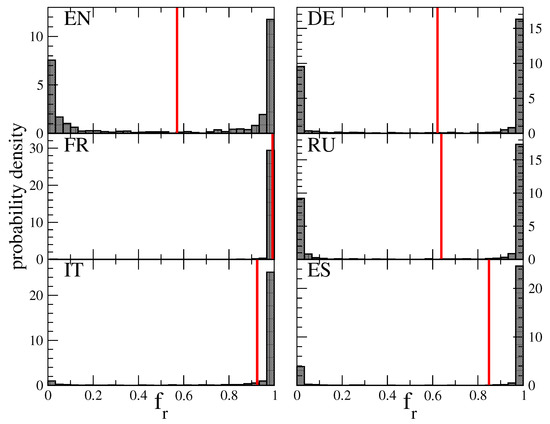
Figure 3.
Same as in the previous figure, each panel, for OP2, corresponds to one of the six different languages of Wikipedia for the initial condition with two fixed red nodes (socialism, communism) and two blue nodes (capitalism, imperialism). The values of mean polarization are for EN, for DE, for ES, for FR, for IT, and for RU. The histogram is built with a cell size and normalized to 1 ().
We note that, in the relation for in (1), we only use matrix elements without dangling nodes. The reason for this choice is due to the fact that the matrix elements (or their parts) that are the same for all nodes in a column or in the entire matrix (as in matrix G with term ) act similar to a certain external magnetic (polarization) field, which gives a contribution proportional to a difference of red and blue node fractions, while we aimed to analyze interactions between node spins without external fields. In the sum of (1), we only include contributions of in-going links given by since, in Wikipedia networks, in-going links are more robust, while out-going links are characterized by significant fluctuations [25]. In this sense, this is different from trade networks where both in-going and out-going links are important, corresponding to imports and exports [12]. In our case (1), all are positive or equal to zero, which corresponds to some kind of ferromagnetic interactions between spins. However, the presence of fixed spins of opposite orientations makes it possible to have a big configurations of spins oriented up or down. It is useful to note that a similar type of relation (1) is used in models of associative memory; however, there, the elements take random values corresponding to some kind of anti-ferromagnetic interactions [26,27]; but fixed spins and the white option for nodes are not considered there.
2.2. Qualitative Description without Formulas
In this Subsection, we give a qualitative description of the INOF model without formulas that highlights its main features. We consider a network of one of six language editions of Wikipedia listed above (e.g., English). The nodes of this network are labeled by the Wikipedia article titles. Spin halves are associated with each article, being red (opinion in favor of this article or spin up) or blue (opinion is against this article or spin down). Initially, there is a group of nodes (or one node, e.g., for the OP1 case) with a fixed color or spin orientation, e.g., red or spin up for the socialism node and blue or spin down for the capitalism node. This color (spin) remains fixed during the whole Monte Carlo process described by the relation (1). At the initial stage, all other nodes that are for the EN edition have a white or a spin of zero. The reason for this is that it is natural to assume that, in the initial state, nodes have a neutral white opinion (no spin polarization; thus, a spin of zero) in favor of capitalism or socialism. Indeed, e.g., the article node labeled football has no opinion about capitalism or socialism initially. However, in the process of Monte Carlo iterations based on the relation (1), the nodes obtain a certain spin polarization depending on the pathway realization of the process. The relation (1) is based on a simple argument that a given article node takes the majority opinion of the other nodes directly linked with it (with certain weights). This is similar to a society model in which a given society member takes the majority opinion of the members directly related (linked) to them. The Monte Carlo process converges to a steady state with fixed spin polarizations, which remain unchanged with further iterations. However, these steady-state spin polarizations depend on a random realization pathway (random shuffle order) of the Monte Carlo process and, due to that, we performed averaging over many realizations to obtain the average spin (opinion) polarization for each article node. The relation (1) corresponds to the Monte Carlo process at a temperature of zero. Thus, an averaging opinion of a given node is determined by the effective influence of the red or blue group of fixed spins (e.g., capitalism or socialism for the OP1 case). The influence is determined by citations/links of fixed articles but not by their detailed text content. We note that the number of possible spin configurations is huge, being about .
We gave above a physical reason why, at the initial stage, spins are taken to be zero (or neutral white for the OP1 case, for the OP2 case). Thus, their opinion is formed as a result of the asynchronous Monte Carlo process being similar to those used in [26,27]. We checked that an initial state, when all spins for OP1 or for OP2 have initial up or down orientations with some random distribution and fixed fraction of red spins, washes out the influence of fixed spins and does not allow their influence to be determined. This is one more reason to use (or ) white nodes in the initial state.
We note that the OP1 cases have only two fixed spins for article nodes capitalism and socialism. The case of OP2 has, in addition, communism as fixed red node and imperialism as fixed blue node. Thus, it allows us to see differences between the two cases that may be rather significant for certain editions (e.g., the Russian edition; see below).
We note that there are certain features of the INOF model present in various types of random field Ising-like models discussed in studies of group decision making (see, e.g., [28,29]). However, overall, the INOF model has significant differences: it is studied on real directed complex networks with their typical complex structure of links [2], it has fixed spins of opposite spin polarizations (red or blue opinions) during the entire process, and, at the initial state, a great majority of non-fixed spins have a neutral white color (spin zero). During the Monte Carlo process, the white nodes’ colors are imposed by the fixed spins that allow to determine the influence of fixed nodes on a global Wikipedia network.
3. Results for Capitalism vs. Socialism
In Figure 1, we show the convergence with time of steady-state values of a fraction of the red nodes ( corresponds to preference for socialism, communism and spin up orientation, for capitalism, imperialism). Data are given for 500 random pathway realizations for each of the six language editions of Wikipedia from the year 2017. The results show that the steady-state values are reached at ; to be completely sure, we show in what follows the steady-state values taken at .
The realizations shown in Figure 1 indicate that the red preference for socialism, communism is different for each of the six Wikipedia editions; thus, the EN case has a comparable number of cases with a final close to unity or zero, while the FR case mainly has an close to unity with close to zero.
3.1. Statistical Properties of Opinion Polarization
To understand the statistical properties of various configurations, we present in Figure 2 and Figure 3 the histograms showing the frequency of appearance of final steady-state values of obtained from one slot of realizations. At first, we stress that almost all final configurations have all red nodes for FR-wiki, with an average of (). A very similar situation takes place for the IT and ES editions with an average of red fractions given in Figure 2 and Figure 3’s captions. The situation is more balanced for the EN, DE, and RU editions. Thus, the results of Figure 3 show that the EN, DE, and RU editions have a certain preference for capitalism, imperialism, even if their preference for socialism, communism is stronger. In contrast, the ES, FR, IT Wikipedia editions have an almost complete preference for socialism, communism. We should note that the steady state of each realization is almost only composed of all red or all blue nodes (only for EN is there a relatively small number of final configurations, which have both red and blue nodes; the number of such mixed configurations is very small for other editions). Such a situation is very different from results obtained for the world trade networks [12] where steady-state configurations had high fractions of red and blue nodes. We attribute this to the different internal structures of Wikipedia and trade networks.
It is interesting to compare the results of the OP1 case in Figure 2, with fixed socialism (red) and capitalism (blue), with those of the OP2 case in Figure 3 when we have fixed socialism, communism (red) and capitalism, imperialism (blue). For five editions, the OP1 case has significantly higher red fractions compared to the OP2 case. Thus, the addition of the fixed red communism note and the blue imperialism one plays against the red opinion. However, the situation is drastically different for RU-wiki: for OP1, it has a very strong preference for capitalism while, for the OP2 case, it has a stronger preference for socialism, communism. We attribute this result to the fact that, from 1917 to 1992, Russia (or, formerly, the USSR) was ruled by the Communist party, which had an official aim to build communism. We note that, in the EN edition, the Russia article has an in-going link from communism and imperialism, but not from socialism and capitalism. In the RU edition, it has no in-going link from socialism, communism; capitalism, imperialism, which probably makes it more influenced by other, longer pathways from fixed nodes. Thus, the imperial period of Russian history, being significantly longer compared to the Soviet period, probably produces a certain trend in favor of the blue fraction (see the discussion about China below).
In fact, Russian Wikipedia was established after the disappearance of the USSR and, thus, it does not have as strong of a stress on political formations. Furthermore, the period that followed after the USSR in 1991–2000 is known in Russia as a period of “wild capitalism”, which is probably at the origin of the strong preference for capitalism for OP1 in the RU edition.
By averaging the spin of each article/node i over realizations, we obtain an average polarization of node i. Ordering all nodes i by the PageRank index K, we obtain the dependence of polarization on K. For EN Wikipedia, this dependence is shown in Figure 4 for OP2 for top PageRank indexes (top panel) and, for the range , the articles socialism, communism are located at ; capitalism, imperialism are located at . Compared to the average global polarization , each article has its own deviation shown in Figure 4. Typically, we have these deviations in the range with some exceptional deviations (of course, four fixed nodes have higher absolute values). We discuss these deviations for specific articles (nodes) below, in the next subsection.
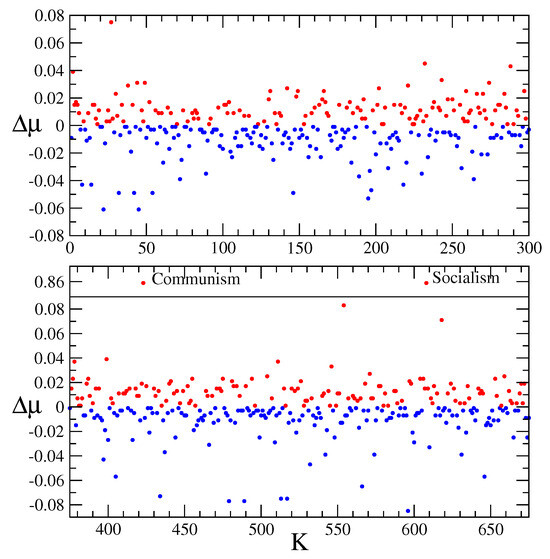
Figure 4.
Average polarization values for the top K nodes () for the EN edition and the OP2 case; here, . Positive and negative are represented by red and blue circles, respectively. The top panel shows the case for the top 300 PageRank ranks (K), while the bottom panel displays ranks from 375 to 675, where the “Communism” and “Socialism” nodes appear in the English language. The average is computed over 1000 iterations after .
It is expected that an average opinion polarization for a given edition is related to the PageRank probabilities and of fixed red and blue nodes (with a rescaled sum equal to unity ) with . For our six editions and the OP2 case, the values of are located in a relatively narrow range, , while the values of are dispersed in the range without any clear correlation with values. For the OP1 case, we have the ranges and , again, without any clear correlation between and values. Thus, we conclude that there is no correlation between and .
After averaging over random pathway realizations, we obtain opinion polarization for all the Wikipedia articles. The distribution histogram or probability density p for these N polarization values is shown in Figure 5 for the EN edition and OP2. The main density is concentrated in the range and centered around the global average polarization . We discuss specific articles with extreme positive or negative values below, in the next subsection.
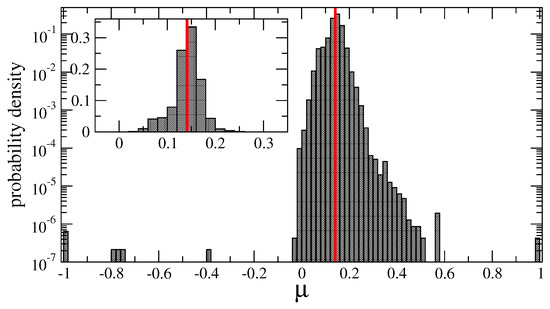
Figure 5.
Probability density of the average polarization value for the English edition for the OP2 case; here, . The main panel displays the probability density on a logarithmic scale, while the inset panel shows it on a linear scale. The average is computed over 1000 realizations and . Red line marks the value .
Similar to the case of the EN edition in Figure 5, we show such histograms for the RU edition for both options, OP1 and OP2, in Figure 6. These histograms clearly demonstrate the drastic difference between the OP1 and OP2 cases, which we attribute to the ruling Communist party of Russia, as we pointed out above.
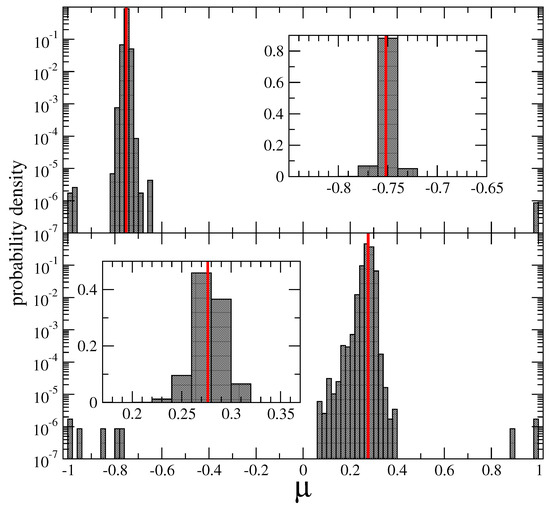
Figure 6.
Probability density of the average magnetization value for the Russian edition for the OP1 (top panel) and OP2 (bottom panel) cases; here, and , respectively. The main panels display the probability density on a logarithmic scale. The top panels represent the initial condition with one fixed red node (socialism) and one fixed blue node (capitalism), while the bottom panels show the initial condition with two fixed red nodes (socialism, communism) and with two fixed blue nodes (capitalism, imperialism), The corresponding inset panels show the same probability density but on a linear scale. The average is computed over 1000 realizations and . Red line marks the value .
It is natural to expect that the Erdös number [2] or Erdös link distance (number of links) from red and blue groups of fixed nodes (we discuss the OP2 case for the EN edition) should significantly influence the opinion formation in the Wikipedia network. To analyze this feature, we show, in Figure 7, a number of network nodes (or frequency) located at distances from two fixed red nodes socialism, communism and from two fixed blue nodes capitalism, imperialism. The number of such nodes grows exponentially with the distance, up to values where there are up to a million nodes ; for larger and values, decreases since, due to the small world effect [2], the majority of network nodes can be reached in links (degree of separation). The interesting feature of Figure 7 is that all nodes are located on three diagonals with . We argue that both groups of fixed red and blue nodes describe human society and, thus, there are close relations (a small number of links) between these two groups. Indeed, for the EN edition, the Erdös distance between these two groups is 1. We found the same three diagonal structures as in Figure 7 for the other five editions.

Figure 7.
Distribution of English Wikipedia articles based on their distance to the red nodes socialism, communism and blue nodes capitalism, imperialism. The color represents the frequency/number of articles as a function of .
In Figure 8, we show the average polarization for each cell located at Erdös distances along the three diagonals for all six editions. The results show that, on average, for a moderate d distance (), we have a larger when the distance to the red group is shorter than to the blue group. This is also clearly visible for the ED, DE, ES, and IT editions while, for the FR and RU editions, this difference is less pronounced.

Figure 8.
Average polarization as a function of the Erdös distance d for the OP2 case. Each panel corresponds to one of the six different languages of Wikipedia: EN (English), DE (German), ES (Spanish), FR (French), IT (Italian), and RU (Russian). Red circles represent nodes that are one step closer to red nodes than to blue nodes (), black circles represent nodes that are equidistant from red and blue nodes (), and blue circles represent nodes that are one step closer to blue nodes than to red nodes (). The average values are given in the caption of Figure 3.
3.2. Opinion Polarization of Specific Articles
We now discuss the opinion polarization of specific articles, concentrating mainly on the EN edition of Wikipedia. Thus, in Table 1, we present top 20 PageRank articles with their polarization opinions for two options, OP1 and OP2, of fixed nodes. In fact, the average global opinion polarization of the whole network gives the average polarization background (see, e.g., Figure 4) and, thus, it is more informative to present the deviations from this background given by .

Table 1.
Top 20 PageRank index K articles of English Wikipedia and for one fixed red node (socialism) and one fixed blue node (capitalism) (OP1), for two fixed red nodes (socialism, communism) and two blue nodes (capitalism, imperialism) (OP2) with a slot of realizations, and for the long run of OP2 realizations. Here, , where is polarization of a given article and is the average global polarization of EN Wikipedia 2017 for OP1 and OP2, respectively. The values of are discussed in Section 6.
There are only three articles with negative values in the top 20 PageRank articles in Table 1 for OP1, while, for the OP2 case, there are eight such cases. This approximately corresponds to a significantly higher peak at for OP2 in Figure 3 compared to the OP1 case in Figure 2 for the EN edition. The main part of this top 20 PageRank list in Table 1 is composed of world countries. Among the other types of articles, we note that Association football and World War I and II have positive values compared to the global positive value of the EN edition network, while has a negative . Due to many in-going links to top PageRank articles, it is difficult to identify the origins of such polarization opinion for these articles.
For the case of world countries, we present an additional Table 2 for the OP2 case showing top 20 countries from the PageRank global list. Here, we find that all European countries from this list of 20 have positive (including Russia). In contrast to that, other countries outside of this area have negative (except Canada and Mexico). We suppose that the positive for European countries is related to the fact that the socialism concept was developed in these countries. The reasons for negative values for Japan and Brazil require a deeper analysis of network link structure. For China and India, we explain the negative in the following way.

Table 2.
Top 20 Countries () given by PageRank index (K) in English Wikipedia and for the case of the two fixed red nodes (socialism, communism) and the two blue nodes (capitalism, imperialism) (OP2) for realizations and realizations: and . The values of are discussed in Section 6.
Thus, for China, we note from Table 1 that is positive for the OP1 case and negative for the OP2 case, which seems to be somewhat surprising in view of the strong influence of the Communist party in China. We argue that this appears to be due to the fact that the word imperialism in Wikipedia becomes linked with the words imperium, empire, emperor, and imperator. Indeed, the article in Figure 5 with an extreme negative value with , is about a servant, Li Yong (chancellor), of the Chinese Emperor Xianzong in the 8th century AD. For thousands of years, China was a powerful empire, which, in our opinion, shifts China to a negative value. Furthermore, China is directly cited by the articles imperialism, capitalism but also by socialism, communism. We note that it happens rather often that an article is cited by fixed articles of opposite opinions.
For India, we found that this article is directly cited by imperialism but not by capitalism, socialism, communism. We attribute such a difference in links to the imperialism and colonization of the UK with respect to India. We also note that, for OP1, without imperialism, the value of is still negative but it is significantly smaller in absolute value compared to the OP2 case with imperialism and . Thus, we think that this is the reason of the highly negative value for India.
The opinion preference of all world countries for capitalism, imperialism or socialism, and communism, expressed by the of countries, is shown in the world map in Figure 9. Positive opinions for socialism, communism with are located mainly in Europe, Russia, Canada, and Mexico. The highest positive values are for Bosnia and Herzegovina (), Romania (), Ireland (), Poland (), Croatia (), and Serbia (). The strongest opinions about capitalism, imperialism with the lowest negative are from India (), Bangladesh (), Cameroon (), Pakistan (), and Madagascar ().
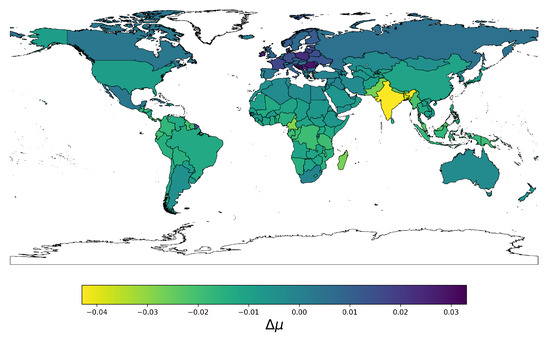
Figure 9.
Geographical distribution of opinion polarization for (socialism, communism) () or (capitalism, imperialism) () expressed by for English Wikipedia. The color legend shows the scale for .
We also considered the preference opinion for a group of historical figures, mainly politicians, presented in Table 3 for the EN edition. They are composed of two groups of 12 figures in each group; the left group in Table 3 is composed of socialist–communist active leaders and politicians (left column) and the right group lists the capitalist political leaders (right column). Indeed, the obtained results show that, for all socialist leaders in the left column, we obtain (enhanced preference for socialism) (left column in Table 3, except Mao Zedong, for whom is only slightly negative, being close to zero). On the other hand, for capitalist leaders, we obtain negative corresponding to an enhanced preference for capitalism (see right column of Table 3) with the exception of Winston Churchill and Charles de Gaulle. We attribute these three exceptions to the fact that all of them are influenced by their countries: Mao Zedong is linked with China, having ; Winston Churchill and Charles de Gaulle are linked with the UK and France, with . We also note that other leaders in Table 3 are linked with Russia with (left column; except Karl Marx) and with USA with . Thus, the proposed method correctly determines the preference opinion of leaders of socialism and capitalism.

Table 3.
Historical figures of English Wikipedia, mainly linked to political and social aspects of human society. The left column presents names more linked to socialism and right column those more linked to capitalism; their polarization opinion is shown for the case of two fixed red nodes (socialism, communism) and two blue nodes (capitalism, imperialism) (OP2) for realizations and realizations: and . The values of are discussed in Section 6.
From Table 3, we note that seven of the twelve political leaders in the right column have exactly the same value. We attribute this to the fact that all of them are presidents of the USA, which probably is at the origin of this feature. Indeed, they are a part of a global article List of presidents of the United States. The other three USA presidents (Roosevelt, Kennedy, and Carter) have different values, which we relate to extraordinary events during their time in office, while Carter has a value not so different from the above seven presidents.
In Table 1, Table 2 and Table 3, there are data for obtained with a significantly higher number of realizations . We discuss this data in Section 6.
It is interesting to consider what the articles with extreme values are in Figure 5 for the OP2 case of the EN edition. These articles are listed in Table 4. To understand the reasons for such extreme values, we consider a few examples of such articles and their in-going links. Thus, Étienne Clavier, who lived in 1762–1817 and was a French Hellinist and magistrate, is only directly cited by the capitalism article, since he referred in French to capitalism in very early 1788, four years before its English usage by A.Young. This leads to an extreme value .

Table 4.
Top 20 negative and positive values of of articles for the case of two fixed red nodes (socialism, communism) and two blue nodes (capitalism, imperialism) (OP2). The articles of this table can be found in Figure 5.
Li Yong (chancellor) with was an official of the Chinese Tang dynasty who lived around 800 AD. This article has in-going linked articles such as Index of China-related articles, Emperor Xianzong of Tang, Chancellor of the Tang dynasty, and eight more in-going links from other articles related to China during this period. Here, we see that, due to links between imperialism and imperium, empire, emperor, and imperator, our approach leads to such an extreme value. Thus, links between similar or related words can produce somewhat artificial links between imperialism and a person who lived in the late 8th century. However, such concepts as imperium, empire, emperor, and imperator are very ancient and explain such an influence by the more modern concept of imperialism.
For extreme positive values, we consider Giliana Berneri who lived in 1919–1998 and was a French doctor of medicine and libertarian communist activist. She was also among the founders of the French Anarchist Federation, which included Maurice Laisant. Their articles have in-going links from articles about other people linked to socialist–communist movements (Camillo Berneri, Berneri, Georges Vincey, Aurelio Chessa, and Giovanna Berneri), which leads to . The article Maurice Laisant is only cited by the articles Giliana Berneri and Georges Vincey, which leads to .
From these examples, we see that extreme values appear for articles that have a small number of in-going links directly coming from fixed opinion articles or by a short path from them. We attribute a certain gap in the highest absolute values of in Table 4 to the different number of Erdös links to the fixed nodes.
Of course, one can study other types of confrontations, e.g., socialism vs. communism, but we restricted our studies to the OP1 and OP2 cases described above.
4. Results for Christianity vs. Islam
Our Monte Carlo approach to opinion formation in Wikipedia networks can also be used for other competing articles. To illustrate another example, we considered the case of Christianity (red) and Islam (blue) in the EN and RU editions. The histograms of steady-state probability distribution of red nodes are shown in Figure 10. These distributions are essentially composed of two peaks at and . The histograms for opinion polarization are shown in Figure 11. These results show that the fraction of opinion in favor of Islam is higher by a factor of about 3–4 (for ) in the RU edition compared to the EN one. We attribute this to a significantly higher percentage of Muslim population in Russia (10–12%) compared to the USA (1%), the UK (5%), Canada (5%), and Australia (3%) (even if these percentages are approximate) [30].
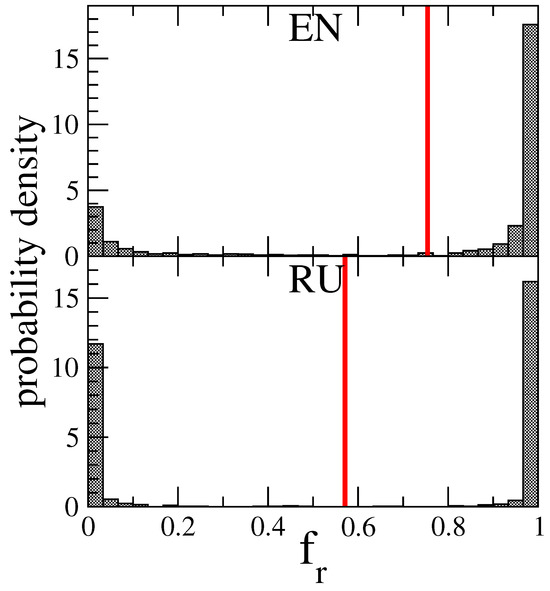
Figure 10.
The same histogram as in Figure 2 but for another pair of fixed nodes (articles), Christianity (red) and Islam (blue) for the EN (top) and RU (bottom) Wikipedia editions; here, the average opinion polarizations are (EN) and (RU), marked by red lines; .
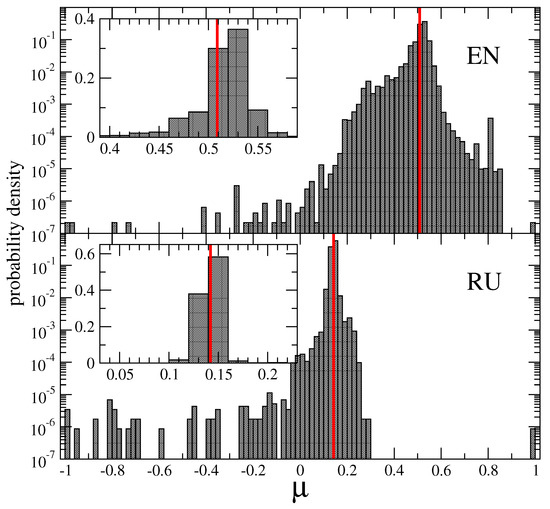
Figure 11.
The same probability histogram as in Figure 5 but for another pair of fixed nodes (articles), Christianity (red) and Islam (blue), for EN (top) and RU (bottom); the red lines mark values of average global polarization opinion (EN), (RU).
The world map of countries characterized by their opinion polarization in shown in Figure 12 for English Wikipedia. The countries with extreme positive and negative opinion polarization, expressed by , that are in favor of Christianity are the following: Ireland (), Bosnia and Herzegovina (), Croatia (), and Poland (); and in favor of Islam: India (), Pakistan (), Bangladesh (), and Nepal (). We found that the values of country are significantly correlated with the percent of the Muslim population of countries M taken from [30]. Thus, the correlation coefficients between and M values are rather high: (Pearson), (Spearman), and (Kendall); see the definitions of these coefficients on Wikipedia.
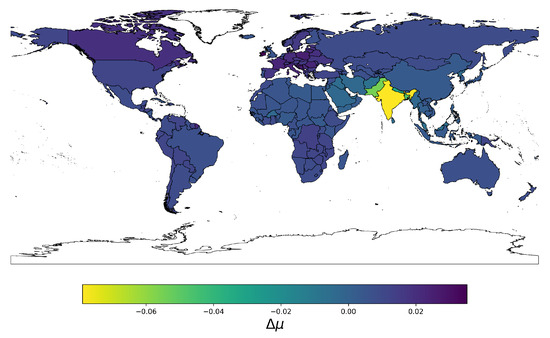
Figure 12.
Geographical distribution of opinion polarization for Christianity () or (Islam) () expressed by for English Wikipedia. Color legend shows the scale for .
For the leading historical figures for Christianity and Islam, we obtained, for the EN edition, the following values: Jesus (0.019), Saint Peter (0.027), and Paul the Apostle (0.029), and Muhammad (−0.005), Ali (−0.005), and Abu Nakr (−0.005).
For the Russian edition of the same articles, we obtained Jesus (0.00195), Saint Peter (0.00195), and Paul the Apostle (0.00195), and Muhammad (−0.006), Ali (−0.006), and Abu Nakr (no article in 2017).
We consider that these results qualitatively correspond to a natural expectation of opinion preference being more on the side of Christianity for Jesus, Saint Peter, and Paul the Apostle and on the side of Islam for Islam for Muhammad, Ali, and Abu Nakr. This confirms the validity of our approach for opinion formation on Wikipedia networks.
Thus, the outcomes of this Section confirm that our INOF model leads to reliable results.
5. Results for Democratic Party vs. Republican Party in USA
As an another example of competition between two opinions, we examined the case of two articles in the EN edition: Republican Party (United States) (red) and Democratic Party (United States) (blue). In this case, the histogram analogous to the one in Figure 2 is still essentially composed of two peaks of different heights at and ; with red and blue fractions being , and . The article United States has with . Thus, the EN edition is significantly more favorable to the Democratic Party.
Globally, on the basis of the obtained results for the directed networks of six Wikipedia editions, we conclude that our INOF model gives reliable statements for confrontations of two opposite opinions in such systems.
6. Statistical Features of INOF Model
For a given edition, the value of average opinion polarization is determined from realizations and N spins of a given realization (we mark this as a slot 1, discussed in previous Sections). Thus, e.g., for the EN edition, is obtained from a summation over approximately spin orientations while the values of articles are obtained from 1000 spins. Thus, one would expect that the values of global polarization and polarization of an individual article would be statistically very stable. However, when we performed a comparison with another slot 2 with other random pathways, we obtained a notable change of and values. At the same time, the fractions of white nodes in the steady state, related to isolated communities, remained the same for different slots. Furthermore, the extreme values of , as those in Table 4, showed little to no changes for different slots, unlike the articles in the main part of probability distribution. We attribute this to the fact that such extreme articles have short links to the fixed nodes and, hence, are only weakly affected by pathway realizations.
As an example, we show in Figure 13 the probability distributions for five random slots with for the EN edition and five slots with for the RU edition. There is a visible modification of the shape of the distribution. The values of the five approximately vary in a range of 25–30% for the RU and EN editions compared to the average of these five values of .
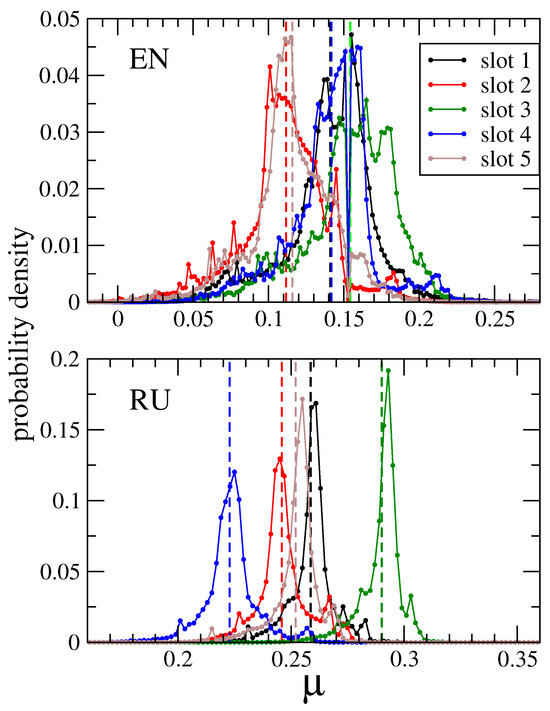
Figure 13.
Probability density of the average opinion polarization value for the English edition for OP2 (top panel) and for the Russian edition for OP2 (bottom panel). The five slots of the model are represented by curves of different colors, with 1000 realizations per slot for EN and 2000 for RU. The slot 1 discussed in previous sections has a black color. The bin width in is , and the values of slots are represented by dashed vertical lines corresponding to the same color as the distribution.
The effect of variations for the specific articles of 194 world countries is shown in Figure 14 as the world map of countries for slot 5, to be compared with the result of Figure 9 for slot 1. We see that the individual values of countries are changed in these two figures but the global features of opinion polarization remain similar.
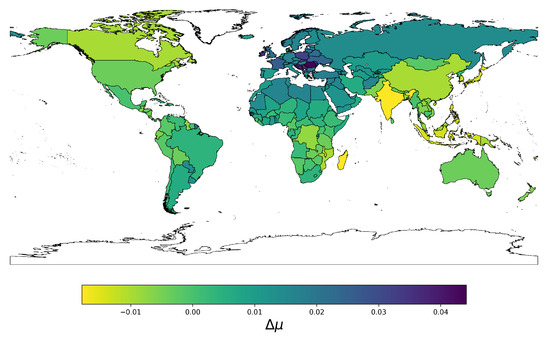
To characterize the similarity between values in the five presented slots of the EN and RU editions in Figure 13, we computed the correlators between the values of these five slots. There are 10 different correlators from the five EN slots (and 10 for the five of RU). These 10 correlators have similar values C and, due to that, we only give here their average value and the standard deviation obtained from these 10 correlators. Thus, only for the correlators of the articles of 194 countries, we obtained (Spearman), (Pearson), and (Kendall) for the OP2 case of the EN edition. If we compute these 10 correlators for all N articles of the OP2 case of the EN edition, then we find (Spearman), (Pearson), and (Kendall); thus, for all articles, the correlators are even higher. The definitions of the three correlators used, Spearman, Pearson, and Kendall, can be found on Wikipedia.
For five slots of the RU edition of Figure 13 with all articles, we have similar correlator values, being (Spearman), (Pearson), and (Kendall).
Thus, the correlator analysis shows that different slots have highly correlated values but the fluctuations of values from slot to slot are still significant for the number of realizations used in previous sections.
With the aim of reducing these fluctuations of opinion polarization, we significantly increased the number realization, going up to . This allowed to obtain a significant reduction of fluctuations of values of individual articles, as is shown in Figure 15 for the EN and RU editions of the OP2 case. We note that a run with realizations for the EN edition takes 5 days of CPU time on a 40 core processor.

Figure 15.
Probability density of the average opinion polarization value for the English edition for OP2 (top panel) and for the Russian edition for OP2 (bottom panel). The two slots of the model are represented by black and red curves, with realizations per slot for EN and RU. The bin width in is , and the values of slots are represented by dashed vertical lines corresponding to the same color as the distribution. The data of slot 1 are marked by a black color; they are used in Table 1, Table 2 and Table 3.
To illustrate a difference between two slots, we show the density of articles in a plane of their values, averaged over realizations, for slot 1 and slot 2 of the EN edition (OP2 case), shown in Figure 16. The width of the distribution characterizes the fluctuations of values, which are maximal near the global average values of for slot 1, where the density of articles is the highest. For articles at the extreme values, the fluctuations are reduced, which we attribute to short pathways between these articles and the fixed red or blue ones.
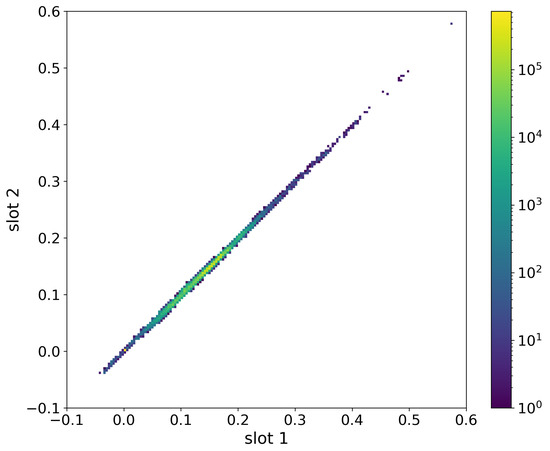
Figure 16.
Density distribution of number of articles in the plane of values for the INOF model across two slots with realizations each. Each article has a value, given in the axes, for slot 1 and slot 2, and the number of articles in this plane is represented by a color scale in the density distribution using a logarithmic scale. White indicates regions without articles.
To obtain a quantitative characterization of fluctuations and their dependence on the value, we define an average variation of as , where is the average polarization of slot j, is the number of slots, and is the average for slots. We also define the average dispersion of individual article polarization as , where two different slots (1 and 2) are compared in each of the N articles, and the result is averaged over different slot pairs.
The dependences of and on are presented in Figure 17 for the Wikipedia editions. For , the dependence on is well described by the expression with (for the FR case, , which can be attributed to its being very close to 1). The fits of the decay exponent give for five editions; this value is very close to , corresponding to the inverse square root decay. For , the exponent is also close to for the EN and ES editions, while, for the RU edition, fluctuations of are too high to obtain a reliable value of . At present, we have no theoretical explanation for the exponent being close to for the main part of the editions.
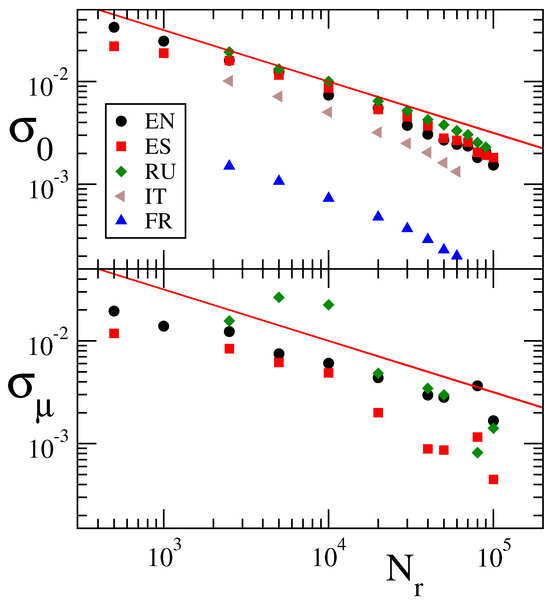
Figure 17.
The top panel shows the average variation of for different slots as a function of the number of realizations per slot (). The power law fit for EN, ES, RU, FR, and IT languages have exponents of , , , , and , respectively. The bottom panel represents the average dispersion of individual article polarization vs. . The power law fit for EN, ES, and RU languages have exponents of , , and , respectively. The red line in both panels illustrates the power law with exponent with . The number of slots used to compute varies from 40 for to 2 for .
In Table 1, Table 2 and Table 3, for specific articles, we compare the values of obtained with and realizations. Practically, for all articles presented in these tables, the difference in values is only in the third digit that approximately corresponds to the standard deviation from Figure 17. Thus, the small values of should be taken with caution. As an example of changes in at higher statistics of , we may note, e.g., United States, Brazil, and Turkey in Table 2, which obtain positive values at higher statistics. However, the changes of are still in the third digit. In Table 3, the high number of moves Mao Zedong to a positive value; from the capitalistic side of this table, all politicians with a negative at are moved to positive values at ; but their values still remain smaller by a factor of three compared to the case of politicians with the socialistic orientation in the left column.
Finally, in Figure 18, we show the opinion polarization for world countries for the OP2 case of the EN edition obtained with realizations (slot 1 in Figure 15). There is a clear dominance of socialistic orientation for a main number of countries, especially in Europe and Russia. The global features of this world map are similar to those shown in Figure 9 and Figure 14, obtained with . However, it is clear that the results of Figure 18 are much more stable with respect to fluctuations.
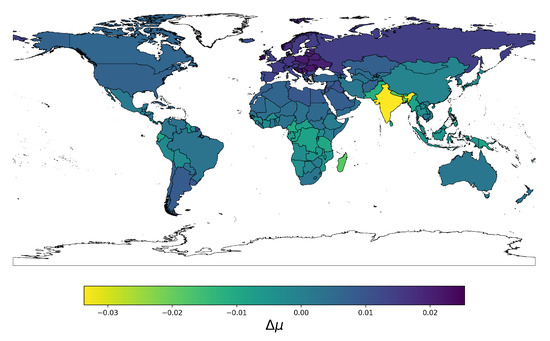
Figure 18.
Geographical distribution of opinion polarization preference for socialism, communism () or (capitalism, imperialism) () (OP2) expressed by for English Wikipedia and the long run of realizations (slot 1 in Figure 15). The color bar shows the scale for .
An interested reader can find the map of world countries’ opinion polarization for all six Wikipedia editions at high in [31]. For all the articles of these six editions, the opinion polarization values for the OP2 case are also available in [31]. For the OP2 case at , we also determined opinion polarization for the English edition (expressed by ) for universities from the top Wikipedia Ranking of World Universities 2017, found in [14]. It is interesting to note that practically all top 100 universities have a preference for socialism, communism () and only 11 of them have a preference for capitalism, imperialism (; they start from rank 30). All preferences of 1000 world universities expressed by are given in [31].
Finally, let us discuss a possible concern that the INOF model does not take into account the context of Wikipedia articles, only taking into account links and spin polarization on nodes. Here, we point out that the PageRank method applied to the World Wide Web, Wikipedia networks, and the world trade network also does not take into account the context of a given web page, Wikipedia article, or the political opinion of a trade country. However, the PageRank algorithm, which, in a certain sense, counts the number of links in a specific manner, correctly performs ranking of world web pages [23,24], historical personalities of Wikipedia, being in a good agreement with historical analysis [25], world university rankings [14], and the commercial power of countries [12]. The approach used in the INOF model is very similar to those used in various vote models of opinion formation (see, e.g., [5,6,7,8,28,29,32]): a given node (society member) takes an average weighted opinion of other members related/linked to them. This is also very similar to various models of magnetism where a given spin polarization is determined by neighboring linked spins. Of course, this INFO approach is not perfect. Indeed, for example, certain articles, e.g., China, have direct links with capitalism, imperialism and socialism, communism that can produce a collision of opposite spin polarizations and certain fluctuations. However, as the results of the PageRank algorithm show, the result is statistically stable and reasonable for the ranking of Wikipedia articles according to their importance. In certain sense, we can say that, if the article Etienne Clavier is directly linked to an article capitalism, then it means that it was important for capitalism, even if it would be better to know the content of these two articles—that, however, is rather difficult for the statistical analysis of the huge amount of content on Wikipedia. In a certain sense, the case of capitalism pointing to Etienne Clavier is similar to the case when the web page www.google.com points to the web page of a certain company: of course, it is useful to know the reasons behind this, but, already, the mere fact of such a direct link rises the visibility and importance of such a company significantly (certain companies are even ready to pay for that). The link proximity and the number of links only give an approximate measure of opinion (or preference for capitalism or socialism) but we think that, statistically, this approach works well as it is shown, e.g., by the discussion of the politicians in Table 3 and the three correlators for Christianity and Islam, which are correlated with the percentage of the Muslim population in countries (Section 4) and other features discussed above. Thus, on the basis of the above arguments, we argue that the INOF model provides a useful statistical description of various opinion preferences in directed networks.
7. Discussion and Conclusions
We developed the Ising Network Opinion Formation (INOF) model and applied it to the analysis of opinion formation in Wikipedia networks of six language editions of the year 2017. In this model, Ising spins with fixed opposite directions present certain fixed opinions, red or blue, of selected network nodes. All other nodes have an initial zero spin, or a white opinion. Then, the Monte Carlo step procedure determines the inversion of spins, determined by their in-going links until a steady-state polarization of all network spins is reached. This allows to determine the global opinion preference of the whole network as well as the opinion polarization of individual nodes.
We mainly considered the confrontation of capitalism, imperialism and socialism, communism. We found that, for six Wikipedia editions (EN, DE, ES, FR, IT, and RU), the majority opinion is in favor of socialism, communism. The variations of opinion preferences for the world countries, political leaders, and other Wikipedia articles were determined to be in good agreement with simple heuristic expectations. We also provided arguments for certain deviations from such expectations.
In addition, we considered the opinion formation given by interactions between Christianity and Islam for the EN and RU editions. The INOF model naturally gave a significant preference for Christianity in EN Wikipedia while the preference of RU Wikipedia was significantly more balanced. The INOF model determined the preference balance for the world countries that have a high correlation coefficient with the Muslim population of countries for the EN and RU editions.
We also considered the competition of the US Democratic and Republican Parties in EN Wikipedia from 2017. The global opinion preference was found to be significantly in favor of Democrats.
We note that the INOF model may have some uncertain situations, like, for example, the case of article China, which has in-going direct links from capitalism, imperialism and from socialism, communism. However, in the great majority of studied cases, the model gave good realistic opinion preferences.
On the basis of the obtained results, we expect that the proposed INOF model will find various applications for opinion formation in numerous directed networks.
Author Contributions
All authors equally contributed to all stages of this work. All authors have read and agreed to the published version of the manuscript.
Funding
The authors acknowledge support from the grant ANR France project NANOX N° ANR-17-EURE-0009 in the framework of the Programme Investissements d'Avenir (project MTDINA).
Institutional Review Board Statement
Not applicable.
Informed Consent Statement
Not applicable.
Data Availability Statement
The data presented in this study are available on request from the corresponding author.
Acknowledgments
We thank K.M.Frahm for useful discussions.
Conflicts of Interest
The authors declare no conflicts of interest.
References
- Castellano, C.; Fortunato, S.; Loreto, V. Statistical physics of social dynamics. Rev. Mod. Phys. 2009, 81, 591–646. [Google Scholar] [CrossRef]
- Dorogovtsev, S. Lectures in Complex Networks; Oxford University Press: Oxford, UK, 2010. [Google Scholar]
- Wikipedia Contributors. Social Media Use in Politics—Wikipedia, the Free Encyclopedia. 2024. Available online: https://en.wikipedia.org/wiki/Social_media_use_in_politics (accessed on 31 May 2024).
- Fujiwara, T.; Muller, K.; Schwarz, C. The Effect of Social Media on Elections: Evidence from The United States. J. Eur. Econ. Ass. 2023, 22, jvad058. [Google Scholar] [CrossRef]
- Sznajd-Weron, K.; Sznajd, J. Opinion evolution in closed community. Int. J. Mod. Phys. C 2000, 11, 1157–1165. [Google Scholar] [CrossRef]
- Sood, V.; Redner, S. Voter Model on Heterogeneous Graphs. Phys. Rev. Lett. 2005, 94, 178701. [Google Scholar] [CrossRef]
- Watts, D.J.; Dodds, P.S. Influentials, Networks, and Public Opinion Formation. J. Consum. Res. 2007, 34, 441–458. [Google Scholar] [CrossRef]
- Galam, S. Sociophysics: A review of Galam models. Int. J. Mod. Phys. C 2008, 19, 409–440. [Google Scholar] [CrossRef]
- Schmittmann, B.; Mukhopadhyay, A. Opinion formation on adaptive networks with intensive average degree. Phys. Rev. E 2010, 82, 066104. [Google Scholar] [CrossRef]
- Kandiah, V.; Shepelyansky, D. PageRank model of opinion formation on social networks. Phys. A 2012, 391, 5779. [Google Scholar] [CrossRef]
- Eom, Y.H.; Shepelyansky, D.L. Opinion formation driven by PageRank node influence on directed networks. Phys. A Stat. Mech. Its Appl. 2015, 436, 707–715. [Google Scholar] [CrossRef]
- Coquide, C.; Lages, J.; Shepelyansky, D.L. Opinion Formation in the World Trade Network. Entropy 2024, 26, 141. [Google Scholar] [CrossRef]
- Frahm, K.M.; Shepelyansky, D.L. Wikipedia Network Data Sets for 24 Language Editions Collected in 2017. 2017. Available online: https://www.quantware.ups-tlse.fr/QWLIB/24wiki2017/index.html (accessed on 31 May 2024).
- Coquide, C.; Lages, J.; Shepelyansky, D.L. World influence and interactions of universities from Wikipedia networks. Eur. Phys. J. B 2019, 92, 3. [Google Scholar] [CrossRef]
- Demidov, D.; Frahm, K.M.; Shepelyansky, D.L. What is the central bank of Wikipedia? Phys. A 2020, 542, 123199. [Google Scholar] [CrossRef]
- Reagle, J.M. Good Faith Collaboration: The Culture of Wikipedia; MIT Press: Cambridge, MA, USA, 2010. [Google Scholar]
- Nielsen, F.A. Wikipedia Research and Tools: Reviews and Comments. SSRN Electron. J. 2012. [Google Scholar] [CrossRef]
- Ball, C. Defying easy categorization: Wikipedia as primary, secondary and tertiary resource. Insights 2023, 7, 1. [Google Scholar] [CrossRef]
- Arroyo–Machado, W.; Diaz-Faes, A.A.; Herrera-Viedma, E.; Castas, R. From academic to media capital: To what extent does the scientific reputation of universities translate into Wikipedia attention? J. Assoc. Inf. Sci. Technol 2024, 75, 423. [Google Scholar] [CrossRef]
- Marx, K. Das Kapital: Kritik der Politischen Oekonomie. Vol. 1: Der Produktionsprozess des Kapitals, 1st ed.; Verlag von Otto Meissner: Hamburg, Germany, 1867. [Google Scholar] [CrossRef]
- Schumpeter, J.A. Capitalism, Socialism and Democracy; Routledge: London UK, 1976. [Google Scholar] [CrossRef]
- Chavance, B. Chapter 2: The historical conflict of socialism and capitalism, and the post-social ist transformation. In Trade and Development; Toyem, J., Ed.; Edward Elgar: Cheltenham, UK, 2003; p. 16. [Google Scholar] [CrossRef]
- Brin, S.; Page, L. The anatomy of a large-scale hypertextual Web search engine. Comput. Netw. ISDN Syst. 1998, 30, 107. [Google Scholar] [CrossRef]
- Langville, A.; Meyer, C. Google’s PageRank and Beyond: The Science of Search Engine Rankings; Princeton University Press: Princeton, NJ, USA, 2006. [Google Scholar]
- Ermann, L.; Frahm, K.M.; Shepelyansky, D.L. Google matrix analysis of directed networks. Rev. Mod. Phys. 2015, 87, 1261. [Google Scholar] [CrossRef]
- Hopfield, J.J. Neural networks and physical systems with emergent collective computational abilities. Proc. Nat. Acad. Sci. USA 1982, 79, 2554. [Google Scholar] [CrossRef] [PubMed]
- Benedetti, M.; Carillo, L.; Marinari, E.; Mezard, N. Eigenvector dreaming. J. Stat. Mech. 2024, 2024, 013302. [Google Scholar] [CrossRef]
- Galam, S.; Moscovici, S. Towards a theory of collective phenomena: Consensus and attitude changes in groups. Eur. J. Soc. Osychology 1991, 21, 69. [Google Scholar] [CrossRef]
- Galam, S. Rational group decision making: A random field Ising model at T = 0. Phys. A 1997, 238, 66. [Google Scholar] [CrossRef]
- Wikipedia Contributors. Islam by Country—Wikipedia, the Free Encyclopedia. 2024. Available online: https://en.wikipedia.org/wiki/Islam_by_country (accessed on 1 July 2024).
- Ermann, L.; Shepelyansky, D.L. Additional Data for This Article. 2024. Available online: https://www.quantware.ups-tlse.fr/QWLIB/isingwiki/ (accessed on 28 July 2024).
- Galam, S. Majority rule, hierarchical structures, and democratic totalitarianism: A statistical approach. J. Math. Psychol. 1986, 30, 426–434. [Google Scholar] [CrossRef]
Disclaimer/Publisher’s Note: The statements, opinions and data contained in all publications are solely those of the individual author(s) and contributor(s) and not of MDPI and/or the editor(s). MDPI and/or the editor(s) disclaim responsibility for any injury to people or property resulting from any ideas, methods, instructions or products referred to in the content. |
© 2024 by the authors. Licensee MDPI, Basel, Switzerland. This article is an open access article distributed under the terms and conditions of the Creative Commons Attribution (CC BY) license (https://creativecommons.org/licenses/by/4.0/).